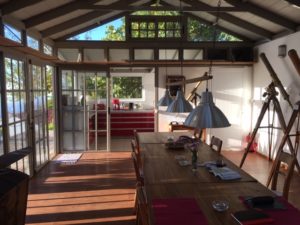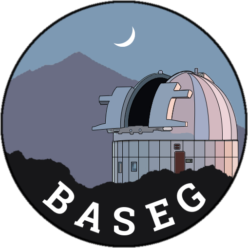Situated in Las Tricias, in the region of Garafia on the western side of La Palma is the Athos Star camp. Occupying the site of a former botanical gardens the 45,000 square metre site has now been converted to a magnet for astronomers from across Europe.
As Dave and I were already staying at a villa nearby we contacted Kai, the owner, to arrange a visit to the camp to check out the location and the facilities.
Dave had previously marked the camp on Google Maps but when we were told to turn down a little track off the LP1 we declined, remaining on the main road for another couple of kilometres (and loads of bends) we reached Las Tricias village and turned up an equally tiny track and proceeded to wind our way back up the hillside, eventually arriving at the gate of the facility.
Kai greeted us and invited us into the Office, where you start to get an idea of the kit that he has available, filter wheels, narrow band filters, cameras and of course loads of scopes and mounts! After a quick chat we joined him on a tour of the site.
First light at the site was only in 2016. This followed a four year search to find somewhere suitable and the area seems to have its own micro climate, with it is claimed, about 300 clear nights a year, due to it being between the two inversion layers of cloud at 900 metres.
The site has five separate villas, with accompanying observing space, and four of these are round the central area whose hub is the ‘Orangery’ which is a library/meeting area where guests can mingle both during the day and also between observing sessions at night. One villa is completely self-contained, and could sleep 3 but only has one observation pad. The other four villas have separate bathrooms but share the cooking facilities in the Orangery.
The Villa rooms are (apart from one) twin occupancy, and the price quoted is for the room; i.e. could be divided in two if shared. Cost in the region of Euros ~400 for 5 nights plus extra nights at Euro ~70.
From the astronomy side each observing pad has a concrete base with surrounding railing, which feature innovative tables (with power sockets) that can be moved to different locations around the rail. This enables the use of a laptop for telescope control or a red light for drawing.
The list of equipment for hire is extensive, with a capital E! There is no obligation to hire and the choice for each individual will be based on whether they want to bring their own kit out from the UK with which they are familiar or to rent for example an EQ6 mount for 6 nights, thus removing the need to have an extra case on the plane and the cost that that involves.
So on a preliminary basis the site offers self-catering facilities at a reasonable cost without the need to cart heavy items out from home.
However Athos offers much much more. If you have dreamed of using a 25” Dob, there’s one for hire. Narrow band filters, CCD cameras, Dobs, SCTs and a range of refractors are all available.
 There is also a fully fitted observatory equipped with a C11 and a 7” refactor, dual mounted and operated from the control room below. Yes it will set you back Euros 290 per night, but for one night split 3 ways maybe affordable as a treat?
There is also a fully fitted observatory equipped with a C11 and a 7” refactor, dual mounted and operated from the control room below. Yes it will set you back Euros 290 per night, but for one night split 3 ways maybe affordable as a treat?
Availability around new Moon is of course a little difficult necessitating booking into later 2019 or even into 2020 in order to get your chosen time and all 5 villas available.
In conclusion superb facilities well worthy of consideration for amateur astronomers looking for clear skies, equipment hire and the chance to go individually or as a group.

